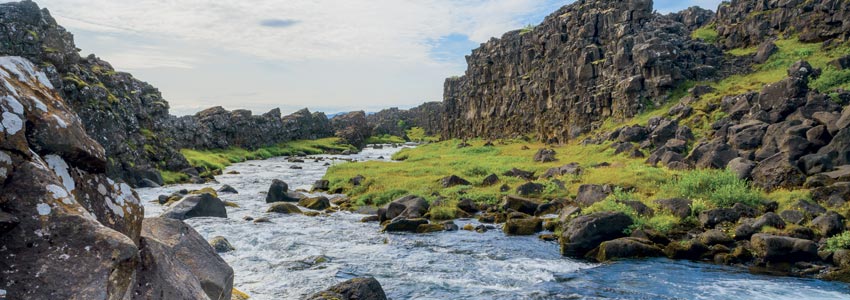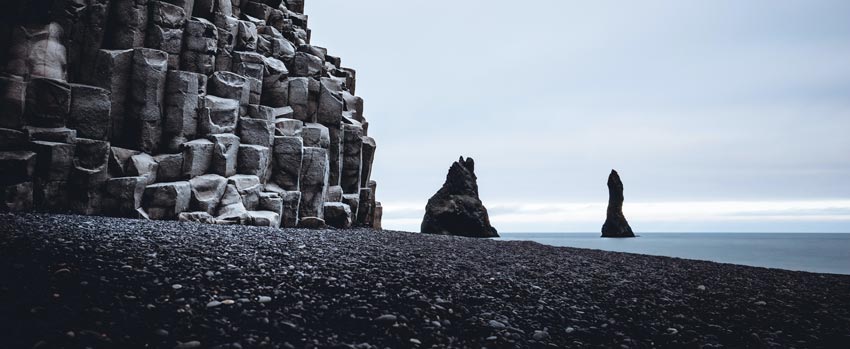George R.R. Martin’s medieval fantasy fiction series, A Song of Ice and Fire, gave birth to the hit TV show, Game of Thrones, on HBO. As the series title suggests, ice is a key element of the story in the white lands that start north of the Seven Kingdoms, sprawling beyond the Wall, and into the mysterious realm of the Wildlings and White Walkers.
What better place to bring us the intense fantasy landscapes of Westeros than Iceland, Land of Fire and Ice? With expansive glaciers, geysers, volcanoes, roaring waterfalls, and geothermal hot springs, the real Game of Thrones film locations in Iceland are even more wild and unbounded than their fictional counterparts. If you want to experience, first hand, where Game of Thrones was filmed in Iceland, plan a vacation around these locations.
Thingvellir (Þingvellir)
It’s difficult to imagine a more dramatic setting than Thingvellir, which is, today, a national park and UNESCO World Heritage site about 25 miles northeast of Reykjavík. During the Viking Age in 930 CE, Iceland’s very first parliament, the Althing, was established here, and assemblies were held at this location until 1798 CE. In essence, Iceland was founded at Thingvellir. But its sensational geography is what makes this one of the most amazing Game of Thrones filming locations for many scenes. Thingvellir sits at the exact place where the North American and the Eurasian tectonic plates are drifting apart. Cracks filled with giant boulders and towering walls are the results.
The Almannagjá gorge at Thingvellir portrays the fictional road to the Eyrie and was also traveled by Arya Stark and Sandor Clegane, “The Hound.” The wildlings also take this trail to the south of the Wall where the Thenn people meet up with Ygritte and Tormund Gianstbane. On the path, Styr, the leader of the Thenn, roasts a human arm on a spit and encourages Tormund to try cannibalism.
Thorufoss (þórufoss)
Not far from Thingvellir is a beautiful natural area with a 40-foot waterfall called Thorufoss which sits above the Laxá í Kjós River. In season 4 of the show, it was here that a young shepherd boy was peacefully guarding his goats when Drogon, Khaleesi’s dragon that she named after her late husband Drogo, rises from the depths of the ravine. Drogon flies ominously over the shepherd’s head, spews his fire to ignite a pretty white goat, snatches up his freshly cooked dinner, and flies away. The real goat that was used in the scene is named Casanova, and he is alive and quite well.
Grjótagjá
Of all the Game of Thrones filming locations in Iceland, Grjótagjá steamed up the camera the most – figuratively and literally. This volcanic grotto in the island’s north near Lake Mývatn contains a geothermal hot spring that becomes the beautiful setting where Jon and Ygritte share an intimate moment together in the 3rd season. This is a love scene that is hard to forget for a number of reasons, not the least of which is the stunning interior of the cave. Historically, an outlaw named Jón Markússon lived in the toasty grotto and used its springs for bathing during the early 1700s. Today, it is one of the most popular Game of Thrones tourist destinations on the island.
Dimmuborgir
Dimmuborgir is a volcanic region that sits between Lake Mývatn and the Hverfjall volcano in the north of the island. The bizarre rock formations and caves give the area a mythological ambiance and are the subject of local folklore that associates the area with hell. In the world of Westeros, this is the encampment to which the wildlings take Jon Snow to meet the King Beyond the Wall, Mance Rayder, in the 3rd season. In another scene that takes place in the “Dark Castles” rock formations of Dimmuborgir, the wildings interrogate Jon Snow about the number of manned castles along the Wall, and Ygritte playfully steals Jon’s sword from him before she leads him into the geothermal cave.
Reynisfjara
Eastwatch-by-the-Sea, the place where the Night’s Watch guard the eastern portion of the Wall, drops down into the fictional Bay of Seals. Scenes of the beach were filmed about two and a half hours from Reykjavík in the south of the island near Vík at the Reynisfjara Black Sands Beach. This is one of the most popular scenic destinations on the island and is the epitome of a dark and dramatic fantasy landscape with large basalt sea stacks that jut out of the water. Overlooking the crashing waves is the 1100 foot Reynisfjell Mountain, consisting of giant stacks of hexagonal columns and a cave.
A famous legend says that two trolls once tried to drag in a three-masted ship one night, but they took too long and hadn’t quite made it to shore when dawn broke upon them. The sunlight turned the trolls and ship into the stones that still stand like sentinels close to the shores of Reynisfjara Beach.
Vatnajökull, Svínafellsjökull, Mýrdalsjökull
Jökull is the Icelandic word for glacier, and the North Atlantic island has 269 of them drawing masses of visitors each year. The vast ice fields with their dramatic terrains have provided the epic fantasy backdrop for many of the scenes north of the Wall. In the southern highlands, Vatnajökull is the largest ice sheet in Europe by volume and claims more than 8% of the island. Svinafellsjökull is an extension of Vatnajökull and also gave us dramatic landscapes in wildling territory. Mýrdalsjökull, the glacier above the village of Vik in the south of the island, was the site of the First of the First Men, while Hofdabrekka (Höfðabrekka) at the foot of Mýrdalsjökull gave us the gorgeous panoramas as John Snow enters the area of the Frostfang Mountains.
Thjodveldisbaerinn (Þjóðveldisbærinn) Farmhouse
Most of the Game of Thrones filming locations in Iceland highlight the country’s spectacular scenery, but this one from season 4 showcases a traditional Settlement-Age village with an interesting backstory. In 1104, the volcano Hekla erupted in the Thjorsardalur (Þjórsárdalur) Valley and covered 20 different Viking settlement sites. Although eight of those sites were excavated, only one still stands at Stöng. The other villages were subsequently buried by multiple eruptions. In 1974, Thjodveldisbaerinn or “Commonwealth farm” Saga-Age Farmhouse was built as a replica of the nearby Stöng settlement. Today it serves as a museum that attracts many visitors.
A notably violent scene took place here in the Game of Thrones’ 4th season when the wildings invade a small village just south of the wall. Everyone is killed except for the young boy, Olly. An intense encounter – the one where the Thenns tell Olly that he must run to Castle Black to tell them that the Thenns are going to eat the boy’s parents – takes place right in front of the village’s church which was constructed based on the excavated church at Stöng.
Thanks in part to the Game of Thrones, the beauty of the Land of Fire and Ice has been revealed to the world. In this place, with some of the most magnificent fantasy film locations on the planet, adventure awaits the eager explorer.
If you’re a fan of Game of Thrones, let your Destination Expert know! They will be able to steer you in the right direction.













